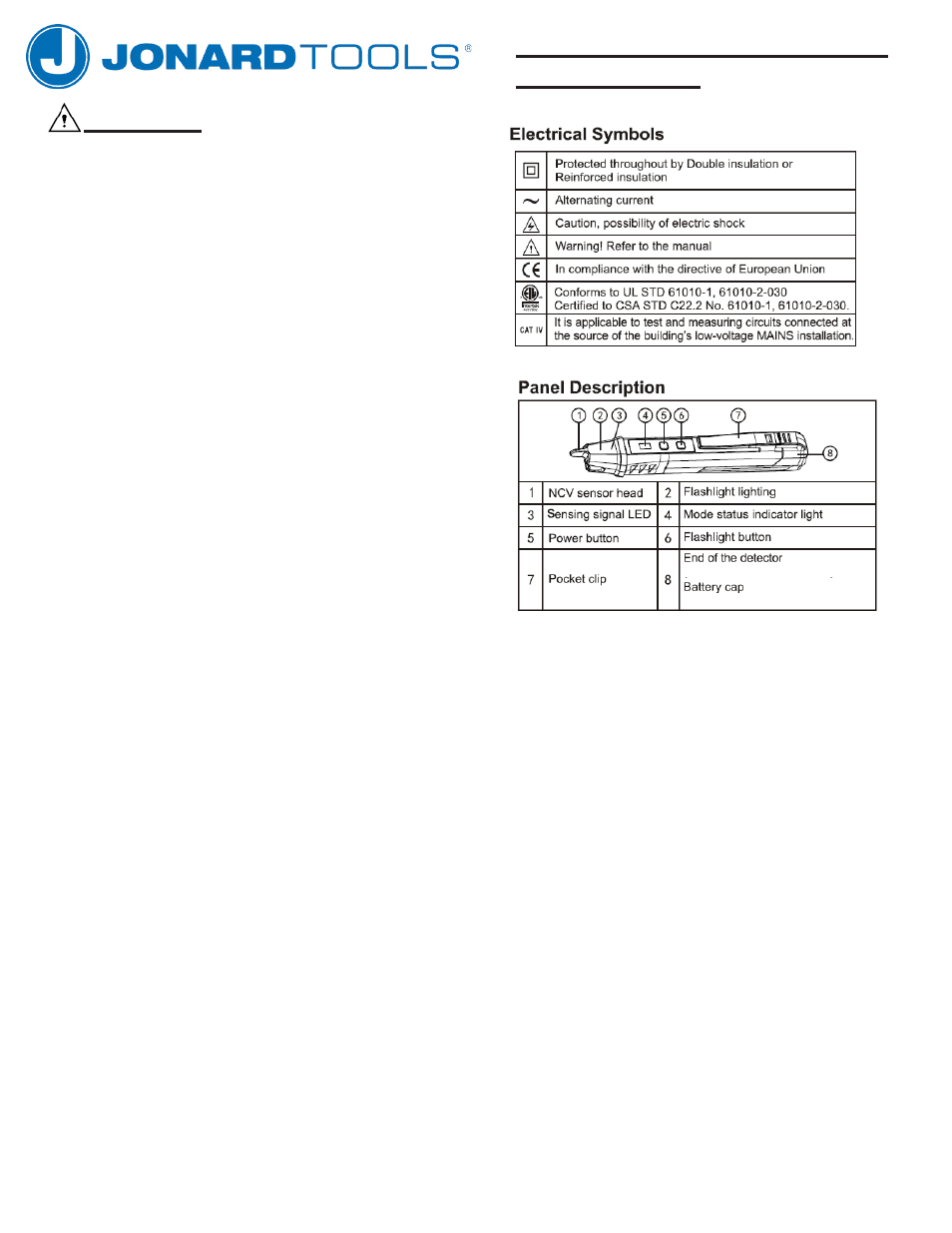Jonard Tools VT-1100 Non-Contact Voltage Detector with LED Flashlight User Manual
Vt-1100 - voltage detector user manual, Warning

WARNING
1. Please carefully read and fully understand the warnings
and operating instructions before use. If the equipment
is used in a manner not specified by the manufactur
-
er, the protection provided by the equipment may be
impaired.
2. Please test the detector on a known live source within
the rated AC voltage range before use.
3. If the detector appears damaged or is not working
properly, stop using it immediately.
4. Do not attempt to detect voltage higher than 1000V.
5. Use caution when working with voltages above AC
30Vr.m.s, 42V peak or DC 60V. Such voltages pose
a shock hazard. Clean the tester casing with a damp
cloth and mild detergent. Do not use abrasives or
solvents!
6. There may still be voltage even when no acousto-optic
alarm is on.
7. The insulation type, wire thickness, distance from
voltage source, shielded wire, other wires, socket
design, and other factors may adversely affect test
result. If there are uncertainties, use other methods to
verify the voltage.
8. Do not assume neutral or ground wire is safe to touch.
Incorrect or poorly connected circuits may cause wires
to be charged.
9. When low battery indication appears, please replace
batteries.
10. Use caution when using the tool, keep hands away
from clear tip.
11. Comply with local and national safety regulations
and requirements.
12. The detector will not detect any voltage if:
• The wire is shielded
• The operator is not connected with the ground or
isolated from effective ground
• The voltage is DC
13. The detector may not detect voltages if:
• The operator does not hold the detector
• The operator is wearing gloves
• The wire under test is partially buried or in a
grounded metal conduit
• The magnetic field generated by the voltage source is
blocked, suppressed or interfered with
• The frequency of the voltage being detected is not
perfect sine wave and may be distorted by harmonics
The detector is used outside of the operating
specifications (see Technical Specification for details)
Low voltage mode (24V AC - 1000V AC)
Suitable for testing low-voltage motor (<90V), audio systems, arc
welding machines, underground mine lighting, cables with thick
insulation layer, and other weak electromagnetic AC signals.
High voltage mode (90 AC - 1000V AC)
For detecting urban electric supply and three-phase systems.
For example, power distribution units, electrical panels, electrical
appliances.
Operating Instructions
1. Turning on the detector
Short press the power button. The buzzer will beep twice
and the red indicator light on the panel will light up, indicat-
ing that the detector is on and ready for use. The default AC
voltage detection range is 90-1000V.
2. Turning on/off the flashlight
Flashlight on/off: Short press the flashlight button to turn
on/off the flashlight. The flashlight will automatically turn off
when the detector is not used for 5 minutes or press
flashlight button again to turn off immediately.
3. AC voltage detection
Place the sensor head near the test object or the power
socket with the AC voltage. When AC voltage is detected,
the red LED in the tip and buzzer will be on. Sensing Buzzer
and LED increase in frequency when the detector gets closer
to the test object.
Note: Please unplug other
electrical devices on the socket before detection.
4. Detection range selection
1) When the detector is on, the default mode is high voltage
mode, with detection range 90-1000V. The red indicator light
will switch to green, and the device will switch to low voltage
mode, with range of 24-1000V. In low voltage mode, the
detector is more sensitive to electrical interferences/noise.
Please only use low voltage mode during weak electrical
field environment.
VT-1100 - VOLTAGE DETECTOR
USER MANUAL
